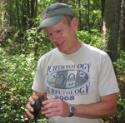 Tim Maret
Tim Maret
Professor
Office Location: FSC 239
Phone Number: (717) 477-1170
Email: tjmare@ship.edu
Education
Eastern New Mexico University B.S. Biology/Chemistry 1982
University of Wyoming M.S. Zoology 1985
Arizona State University Ph.D. Zoology 1995
Profile
I began teaching at Shippensburg University in 1996. Prior to that, I moved around the western United States, earning my BS, MS, and PhD in New Mexico, Wyoming, and Arizona respectively. In between my MS and PhD studies, I spent six years teaching junior high and high school science and coaching track and cross country in northern New Mexico. Although I am interested in anything dealing with ecology or evolution, my real fascination is with the ecology of salamanders, turtles, and vernal ponds. I also have a strong interest in conservation biology, as human impacts threaten the future of the organisms and wild places that I cherish. My wife and I live on a small farm north of Shippensburg, where I spend much of my spare time enjoying the natural world and restoring native habitats.
Research Interests
Ecology and evolution
Conservation biology of amphibians and turtles
Ecology of vernal ponds
Courses Taught
BIO 242 Ecology
BIO 430 Principles of Evolution
BIO 444 Conservation Biology
BIO 522 Community Ecology
Recent Student Research
Matthew Siefert 2020 - Changes in abundance of Virginia bluebells (Mertensia virginica) over time in response to the presence of invasive lesser celandine (Ficaria verna).
Alex Shupinski 2017-2018 - The effects of grazing within wetland easements on vegetation structure and occupancy, abundance and species richness of birds.
Hanna Roos 2017-2018 - Habitat use, movement, and home range of bog turtles (Glyptemys muhlenbergii) in southeastern, PA
Claudia Knutelski 2017-2018 - The impact of population density on survivorship and metamorphosis in wood frogs (Lithobates sylvaticus).
Sam Govan 2016-2018 - Factors influencing the diet of the red-spotted newt, Notophthalmus viridescens, in vernal pools in south central Pennsylvania
Joshua Frost 2017-2018 - Examining pollinator diversity in cattle-grazed and ungrazed wetlands.
Kate Destafano, Alyssa Hay, Emily Sarver, Patrick Boddicker 2014-2018 - Effect of an invasive plant species, Ficaria verna, on a native woodland species, Mertensia virginica, in floodplain forest in south Central Pennsylvania.
Sarah Kropf 2016-2017 - The effects of the neonicotinoid insecticide Clothianidin on survival, growth, and development of larval amphibians and aquatic food webs.
Paul Mashett 2016-2017 - The effects of tannins on predator detection in larval amphibians and predator-prey interactions in aquatic food webs.
Brandon Mullen 2015-2017 - Effects of forest change on leaf processing in vernal pond ecosystems
Karen Schwander, 2015-2016. The Effect of Native and Exotic Invasive Plants on Vernal Pool Composition and Amphibian Growth and Survival
Miranda McCleaf, 2014-2015. An Assessment of the Movement and Habitat Use of Spotted Turtles (Clemmys guttata) during Regrowth of a Managed Area in Pennsylvania
Katie Seymore, 2013-2014. The effect of forest composition and caddisfly larvae (Limnephilus indivisus) on vernal pond communities.
Selected Publications
Mehring, A. S.* and T. J. Maret. 2011. Red maple dominance enhances fungal and shredder growth and litter processing in temporary ponds. Limnology and Oceanography 56:1106–1114.
Mott, C. L.* and T. J. Maret. 2011. Species-specific Patterns of Agonistic Behavior among Larvae of Three Syntopic Species of Ambystomatid Salamanders. Copeia 2011:9-17.
Steele, M. A., M. C. Brittingham, T. J. Maret, and J. F. Merritt, eds. 2010. Terrestrial Vertebrates of Pennsylvania: A Complete Guide to Species of Conservation Concern. Johns Hopkins University Press, Baltimore, Maryland.
Morris, K. M.* and T. J. Maret. 2007. Effects of timber management on pond breeding salamanders. Journal of Wildlife Management 71:1034-1041.
Maret, T. J., J. D. Snyder, and J. P. Collins. 2006. Altered drying regime controls distribution of endangered salamanders and introduced predators. Biological Conservation 127:129-138.
Maret, T. J., and J. P. Collins. 1997. Ecological origin of morphological diversity: a study of alternative trophic phenotypes in larval salamanders. Evolution 5:898-905.
Maret T. J. and J. P. Collins. 1996. Effect of prey vulnerability on population size structure of a gape-limited predator. Ecology 77:320-324.
* student

